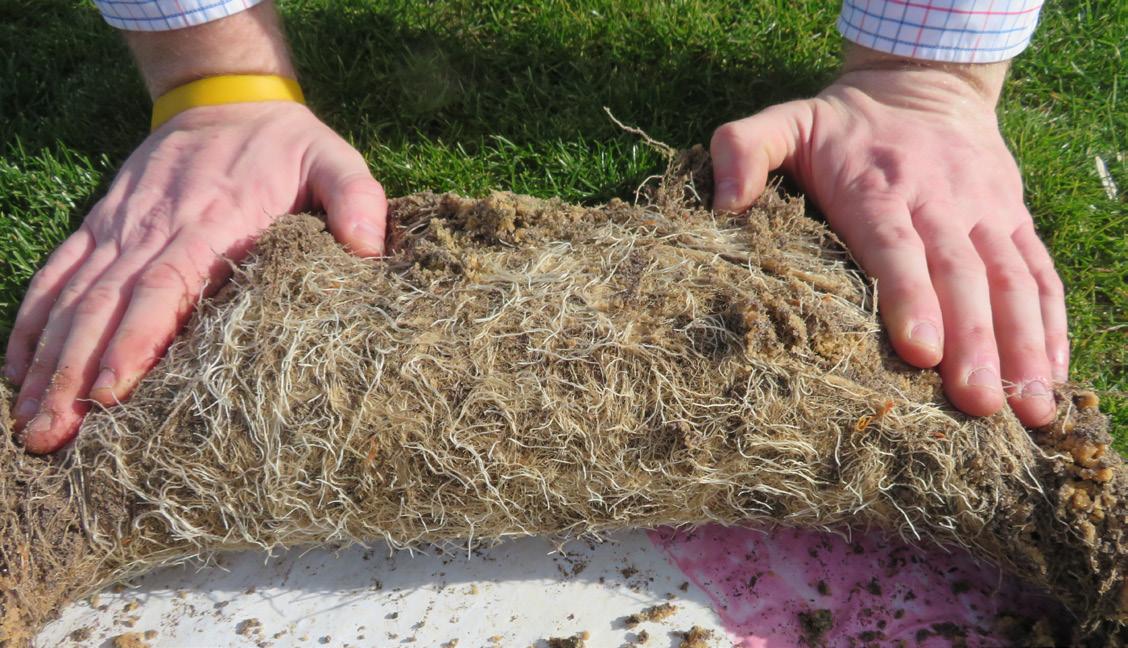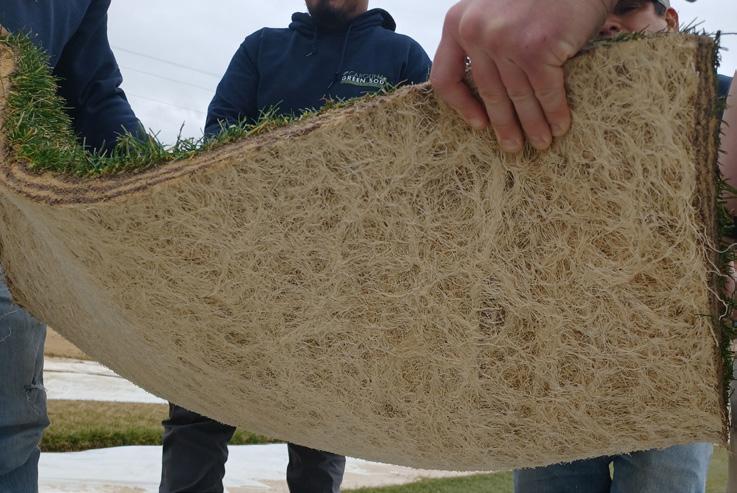
9 minute read
Research News x WinterTurf Research Update x Sod on Plastic Establishment Practices for Kentucky Bluegrass and Perennial Ryegrass
Winterkill sensor package on an ice covered green.
WinterTurf Research Update
By Kevin W. Frank
The classic saying of ‘third time’s the charm’ held true for our WinterTurf grant that was funded in 2021 after our third submission. The WinterTurf research project was funded by the USDA (United States Department of Agriculture) SCRI (Specialty Crop Research Initiative) grant program. The research team represents seven universities (Iowa State, Univ. Massachusetts, MSU, Univ. Minnesota, Rutgers, Oregon State, and Univ. Wisconsin) and one country, Norway (Norwegian Institute of Bioeconomy Research). The full title of our grant is “WinterTurf: A holistic approach to understanding the mechanisms and mitigating the effects of winter stress on turfgrasses in northern climates.” The $8 million grant was funded for 2021-2025. There are many different aspects of winterkill that will be researched. MSU turf team faculty Dr. Vargas, Dr. MerewitzHolm, and myself will be working on different aspects of the grant. I will be focused on researching reestablishment, preventative practices such as cover systems, nitrogen and potassium rate and timing effects on snow mold incidence, leaf mulching effects on snow mold incidence, and of course outreach efforts. There are many exciting aspects of receiving and working with a large group of scientists focused on one issue such as winterkill but probably one of the greatest benefits to our program is enrolling new graduate students. Payton Perkinson started a Masters’ program under my direction officially in May, but even before she graduated from our 4-year turf program she’s already seeded a reestablishment study this spring. Payton is an excellent study who recently won the top award from the GCSAA Scholars Competition, the Mendenhall Award.
Sensors to Monitor Winter Conditions on Greens
In the autumn of 2020, the MTF Founders Society funded the purchase of six sensor packages to monitor winter conditions on golf course putting greens in Michigan. The sensor package was developed by scientists at the University of Minnesota that we’ve been working with as part of the WinterTurf research project. The winterkill sensors we installed at 6 golf courses in Michigan last winter was part of the process of collecting preliminary data to support this grant. The sensor package included: soil temperature and moisture sensors at 3 depths, and oxygen and carbon dioxide sensors. Data collection from the sensors was powered by a solar panel and data was transmitted via real time via a cell signal.
The objectives of this research are:
1) Determine if the sensors reliably record and transmit 2) data throughout the winter Develop a model that could notify superintendents when conditions are likely to • MTF NEWS NOTES | SUMMER 2022 7
cause winterkill. This could be from soil gas, temperature, moisture data or perhaps a combination of all. Ultimately to develop a model we will need to monitor conditions on putting greens when winterkill occurs. 3) Make the sensor package commercially available to superintendents. At least one of our locations in Michigan had ice form on the putting green that was being monitored and the sensors reflected the ice cover as we observed a drop in soil oxygen levels and a concurrent rise in soil carbon dioxide levels. Although we ultimately did not observe any winterkill on that green as the ice only remained in place for about 2-3 weeks, it was interesting to see the sensors recording this data. This is the perfect example of what we’re hoping can be developed, sensors that can record data in real time that the superintendent can use to make decisions such as when to remove ice to minimize the risk of winterkill. The sensor team at Minnesota is still working through all the data from last year, analyzing trends, determining sensor functionality, and correlating data with any observed damage. I would like to thank the following superintendents for hosting sensor packages this past winter. Eric Davey, Prestwick Village Golf Club Drew Paxton, Spring Lake CC Doug Hoeh, Treetops Resort Scott Pulaski, Walloon Lake CC Jim Bluck, Arcadia Bluffs Ryan Moore, Forest Lake CC
Reestablishment Seeding Research
This spring reestablishment seeding research was conducted at MSU, University of Minnesota, University of Wisconsin, and Iowa State University. On three consecutive weeks in the spring of 2022 four creeping bentgrass cultivars and Two-Putt annual bluegrass were seeded into an existing putting green that was killed with glyphosate the previous fall. The bentgrass cultivars were Penncross, Declaration, Pure Distinction and A4. Previous seed germination research at the University of Minnesota found that some bentgrasses displayed high germination rates at low temperatures while others performed poorly. As a first step in our research we designed a study to compare bentgrass cultivars and Two-Putt annual bluegrass over three seeding dates in the spring in the field. We will answer the questions: Payton Perkinson verticutting plots for a winterkill reestablishment trial.

Winterkill establishment trial area.

1) Do cultivars differ in establishment rate, especially in a cold spring 2) Should I seed early or wait until it warms up? This research is the first step in the first year of the WinterTurf grant. In the spring of 2023 we will repeat this trial and expand with additional research that evaluates the effect of covers on reestablishment and other management practices such as nutrient source and rate, and possibly even using pigments to enhance surface warming and germination rates.
Management Practices and Snow Mold
In the fall of 2022, we will conduct research projects in cooperation with the University of Wisconsin to determine the effects of different nitrogen (N) and potassium (K) rates and timings on snow mold incidence on a creeping bentgrass fairway. Plots will start receiving nitrogen and potassium applications starting in May and continuing through August. Different rates of N and K will be applied in September, October, and November. A different study will study the effects of leach mulching in Kentucky bluegrass on snow mold incidence.

Sod on Plastic Establishment Practices
for Kentucky Bluegrass and Perennial Ryegrass
John N. Rogers, III, Jackie Guevara, Ryan Bearss Department of Plant, Soil and Microbial Sciences Michigan State University
Sometimes, when we watch a football or soccer game, we notice tufts of grass flying off the field or sticking on the athlete’s gear. These athletes (bigger, stronger, and faster than ever before) plow through the grass and soil, leaving a beaten-up field at the end of the game. To continue providing an excellent playing environment, field managers are now shifting to building fields that could sustain highperformance demands known as performance turf.
There are two main factors in a performance turf:
• United States Golf Association (USGA) specification rootzone – a sand-based rootzone promotes healthy turfgrass because it is less prone to soil compaction and allows proper drainage. • A traffic-tolerant and high-recovery turfgrass species – species with vegetative stems (i.e., rhizomes and stolons) repairs itself quickly and provides stability to the playing surface. To maximize the playing time on a performance turf, the rootzone of the installed sod should be the same as the existing rootzone. Soil layering – putting a fine-textured soil on top of a sand-based rootzone – leads • MTF NEWS NOTES | SUMMER 2022 9
to poor drainage, increasing soil compaction and reducing turfgrass growth. As a result, we see an increasing demand for compatible sod to repair, renovate and build performance turf fields. However, it is hard to obtain and produce a sod with a compatible rootzone. The sod from traditional production depends on the soil type of the farm. The other factor is the production time of some turfgrass species. For example, Kentucky bluegrass (Poa pratensis; KBG) – a popular turfgrass species used in sports fields – is harvested every 18 months. A way to meet the increasing demand for compatible sod is to grow sod on plastic. Sod grown on plastic, commonly called Sod on Plastic (SOP), is a method of growing turfgrass on a thin layer of growing medium on top of a plastic sheet. We have full control over the growing medium, preventing soil layering issues. Its structure lets roots interweave, increasing tear resistance while reducing production time. Our preliminary data showed that we can harvest sod as early as 4 months. We can put the plastic sheeting down on any surface, allowing us to produce sod anywhere (e.g., non-arable lands, concrete). Other benefits of SOP are preventing transplant shock and providing an instant smooth playing surface during sod installation. Washouts – erosion of the sand due to heavy rainfall/irrigation – have a high chance to take place during the germination period of KBG. KBG usually germinates around 7 to 21 days. During this period, no rooting system will hold the sand particles together. Thus, the main objective of our research project is to identify SOP establishment practices that will stabilize the sand during the initial stages of production while producing durable sod and reducing production time.
Species Composition and Initial Mowing Study
This study will focus on seeding a faster-growing species like perennial ryegrass (Lolium perenne; PRG) with Kentucky bluegrass. PRG germinates around 5 to 7 days, providing stability to the sand mix during the initial stages of production. However, the drawback of this approach is that PRG could dominate the sod. To avoid that, we need to identify the lowest required seeding rate of PRG that will provide stability while producing a KBG-dominated sod. Aside from the seeding rate, the initial mowing schedule also influences the ratio of KBG and PRG in a sod. Thus, we will identify the combination of seeding ratio and initial mowing schedule that will provide the highest stability, strongest sod, and least production time. This study will consist of five KBG: PRG seeding ratios [100:0, 99:1, 97:3, 95:5, 93:7, 0:100] subjected to three initial mowing schedules [1, 2, 3 weeks after seeding]. We will determine the best combination by measuring species composition, percent turfgrass cover, root mass, root density, and sod strength.

This study will focus on increasing the root growth of KBG by applying phosphorus (P) at the establishment and increasing stability to the sand mix by incorporating soil amendments. We will evaluate a combination of soil amendments and P fertilization rates at establishment that will provide the highest stability, strongest sod, and least production time. The study will consist of KBG established on four 1-inch depth sand mixes [USGA specification sand, 80% USGA specification sand: 20% Peat, Crumb Rubber over USGA specification sand] subjected to five P fertilization rates at establishment [0, 0.5, 1.0, 1.5, 2.0 lbs 1000 ft-2]. We will determine the best combination by measuring soil P levels, percent turfgrass cover, shear strength, root mass and density, and sod strength.
Benefit Group
These studies will benefit sod producers as our data could significantly increase their annual sales from reduced production time and increased production using non-arable lands. Our data will also benefit collegiate and professional sports associations by gaining access to reliable sources of compatible and durable sod for midseason repairs and renovation.)









